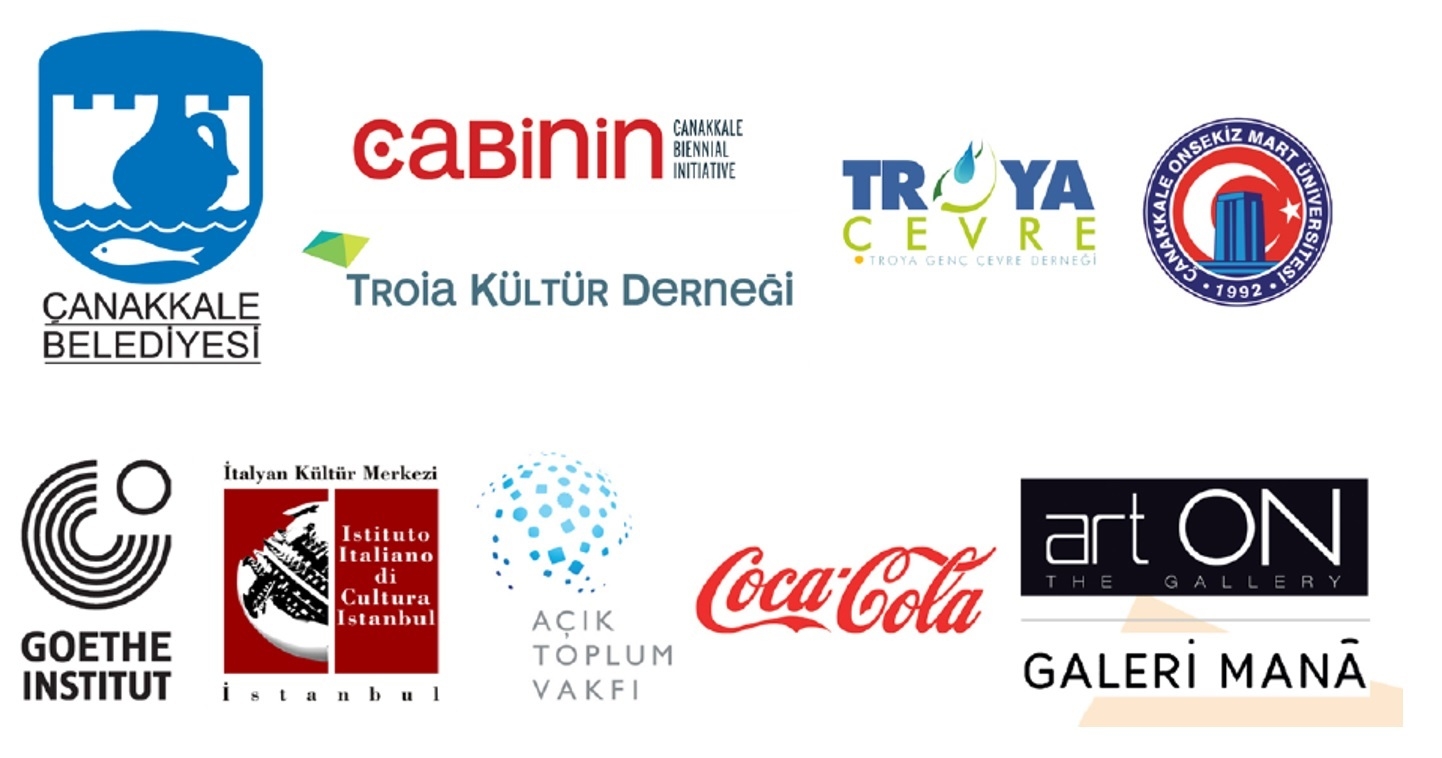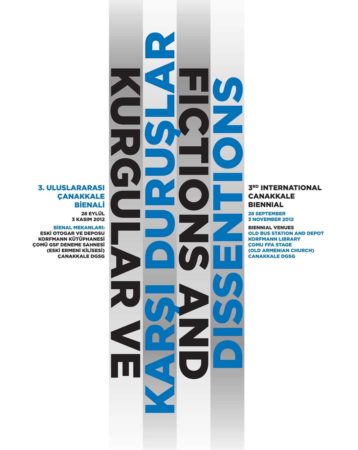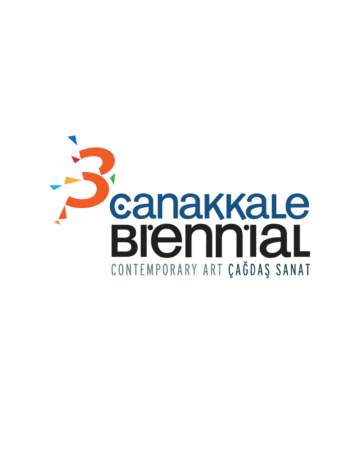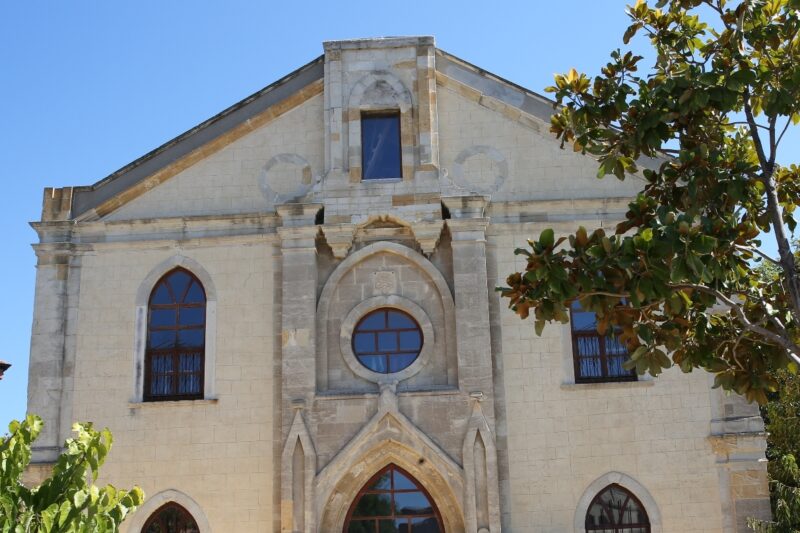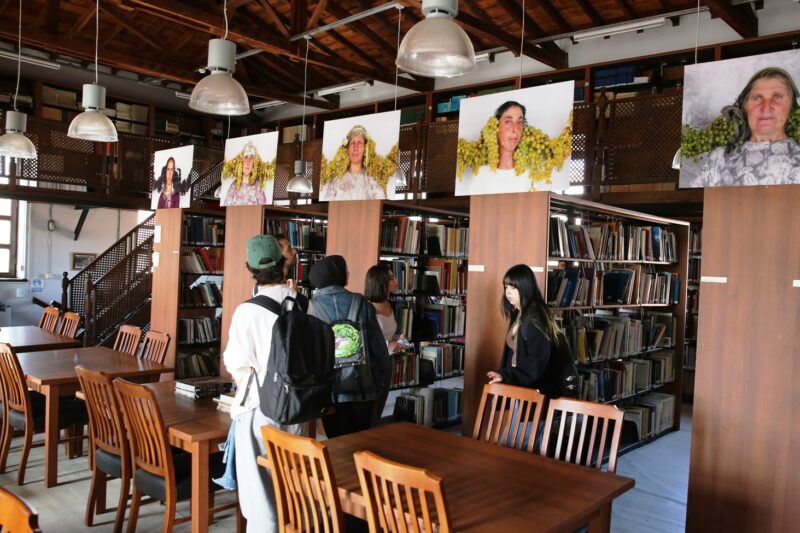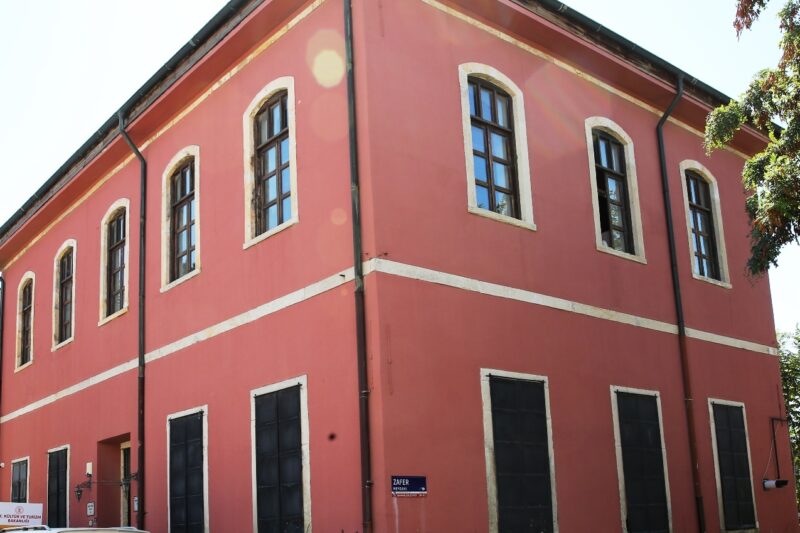Turkey being closely watched from a global perspective has become a focus of attention, not only because of its own political and cultural state of affairs, but also because of "The Arabic Spring" in the region, Iran's bid for nuclear power, its approaches and responses to various countries in turmoil such as Iraq and Syria in a post-USA world politics and no doubt its dynamic relations with the EU.
In relation to all these, recently Turkey also somehow has managed to represent itself as a potential major player in the global art industry, with many worldwide cultural and artistic events and organizations. Turkey has succeeded to attain a unique status in this respect by giving a start to Istanbul Biennial in the mid-eighties, and by realizing Istanbul Cultural Capital of Europe Project in 2010. Now this development, this unique position has been strengthened by various biennial organizations of many emerging Turkish cities like that of Antakya, Canakkale, Mardin and Sinop.
The Third International Canakkale Biennial is contributing to this development with strong commitment and energy.
Canakkale-Gallipoli is a historically loaded city, since it has always been a geopolitical passage way between continents, oceans and civilizations. From the legendary fall of Troy to The Gallipoli Campaign during the 1st World War, Canakkale has always attained a very special place in the hearts and minds of many cultures and civilizations.
The Third International Canakkale Biennial will be held in Canakkale, on the eastern shore of The Dardanelles Straights. This year the Biennial has the aim to portray the intricate realities of political, social and economic world state of affairs in today's global stage. As an artistic event, it will question, analyse and deconstruct the current order of things. It will have a claim, to present visual and performing arts that reflects today's contemporary art aesthetics and dissents.
The Third International Canakkale Biennial will have a particular claim, an argument. That is; today's artists everywhere, can and must create areas of engagement, activity, interpretation so that this alone could constitute an example, a proof that democracy and freedom can in fact be attained on both global and regional levels. This claim also underlines the attributes of creativity, innovation and memory, all may be interpreted as direct results of the Mediterranean socio-political geography in general into which this historic peninsula opens a passage way. But beyond all that, this claim also asserts that art has a politic of its own and this 'art-politics' does in fact competes fiercely with the other mainstream politics, by proving to its public that an alternative way of living together is also indeed possible. Today's contemporary art, especially an art that is based on questioning and analysis is in fact a process, which moves forward slowly but surely and effectively. As a result of this process, it is able to portray many intricacies and ambiguities that are a part of our seemingly ordinary daily lives. Contemporary artists of today work like a detective; He/she researches into the complex web of political, social, economic and cultural issues and portrays them in the most effective forms and concepts that are possible. The artists point to the strong currents beneath the seemingly calm waters and try to reveal the truth. The strong currents in The Dardanelles Straights appear to be an analogy for this act. The currents of The Dardanelles presented many difficulties to Xerxes, who was trying to march his army against Alexander the Great. In 1810, this time Lord Byron crossed the straights and told about it in his poem of Don Juan.
Due to the internet, the network of artists from every corner of the world reduces the size of this vast geography and diminishes the time span of events around the globe. They are capable of learning about many issues, decipher secrets and tackle major problems concerning the whole of humanity in this age of swift information. Now, with this new arsenal at hand, great myths of the past are being rewritten and the post-modern individual position is no longer relevant in the state of current events as testified by ripples of rebellion vibrating through Twitter and Facebook. This is indeed a new epistemological situation which requests a new perception and appreciation. This current organization evidently has not invented the soul of rebellion, but makes possible for waves of rebellion to accumulate.
Modern artists have always questioned the conventions or rebelled against them by indulging into areas of class contradictions, ethnic identities, beliefs, identities and the concept of other. Their methods have been analytical and based on processes. This process opens a horizon based on analysis, appreciation and comprehension of these fast changing space-time notions. To realize and fully comprehend space and time and to operate on political, economic and cultural levels has requested a new way of collaboration and partnership between the artists. Thus, the artist initiatives of today are best active examples of this collaboration. These initiatives are a way to share the experience with the society.
The Third International Canakkale Biennial aims:
To be a platform for viewing and perceiving art that is created within the above mentioned context;
To make visible the geographical boundaries that is being re-drawn
in global dimension, the neo-liberal economy which tries to re-incarnate itself, and in particular the political transformations in the Middle East region. To examine the emerging pressure on the existing political power and evidently all these issues that influenced the daily life;
To exhibits works emanating from a certain concept that supports an existing environment or proposes a new environment;
To discuss and to deconstruct this organized movement that emerges with the new waves of revolution and revives itself.
Thus the Third International Canakkale Biennial:
Will place this historical city into the calendar of international art world by inviting artists and art experts from all over the world, who will contribute to the conceptual framework of this biennial;
Will provide interesting and functional locations such as the Old Bus Terminal, National Fine Arts Gallery, Korfmann Library and the Old Armenian Church;
Will invite the art and culture institutions and universities to join the biennial artists to create an environment of interaction and communication in public space;
Will provide the widest possible discussion of the biennial's conceptual framework with various social and educational programmes such as workshops, debates and conferences;
Will prove the fact that a biennial is not an end in itself, but a sustainable event which demands audience participation and which will become a form of cultural interface for The Mediterranean region;
Will place Canakkale into the global art- culture production and communication networks.
"Art does not produce knowledge and submissions for politics. It produces dissentions & fictions, and the reciprocal interdependence of different kinds of sequences in the realm of sensibility. These it produces, not for political action, but in the framework of its own politics, in accordance with that peculiar double action, which on one hand encourages itself for self-destruction and on the other locks itself in loneliness. Art produces fictionalities and dissents which reorganize the space-time of pages, museums, films and theatre which are in fact forms that demand divisions and subdivisions of general locations of sensibility, alone and together and the interrelations between vision and reality. In this way, art produces-creates forms that provide recreations of experiences. It is indeed the area, in which forms of political subject-agent to come into existence." Jacques Ranciére, Die Aufteilung des Sinnlichen
(Die Politik der Kunst und Ihre Paradoxen), Polypen, 2008, pg.89-90
- Curators: Beral Madra, Fırat Arapoğlu, Seyhan Boztepe, Deniz Erbaş
- General Art Director: Beral Madra
- Founding Director: Seyhan Boztepe
- General Coordinator: Deniz Erbaş
- Coordinators: İsmail Erten, Ezgi Arıduru
- Biennial Child: Erdinç Alnıak, Ezgi Hancı, Seçil Sütçü
- Biennial Youth: Eren Uysal, Oğuz Balcı
- AccessAbility: Cemal Öney, Tahir Akar, Oğuz Birincioğlu, Ece Usta, Ece Güneş Erten, Ayla Yazgan
- Design: Serdar Negir
- Poster Design: Savaş Çekiç
- Web Master: Yıldırım Şahiner
- Production: Erdal Sezer
- Production Assistants: Sertaç Kuru, Burak Topçakıl, Gülsüm Ferman, Yusuf Berk Akpınar
- Logistics: Benice Lojistik
- Photography and Documentation: Tuğba Elmacı, Tuncay Alpı, Ercan Öztabak, Anıl Şentürk, Gökhan Eser
- Translation: Ceren Akıncı, Ezgi Arıduru, Ahmet Sipahioğlu, Servet Kördeve, Neşe-John Guendelsberger
- Çanakkale Municipality Team: Özlem Eryiğit, Mehmet Eşli, Sevil Albay
- Team Leader: Birim Ömer Erol
- Biennial Office and Volunteer Coordination: Oğuz Eyüpler, Begüm Bıçkıcı, İsmail Dönmez, İrem Coşkun
- Artist Assistants: Adem Yavuz, Ayşegül Çetin, Begüm Çavuşoğlu, Umut Özcan, Ceren Akıncı, Ezgi Tokgöz, Metin Dilek, Gizem Alnıak, Cansın Emiş, Ilgın Karadağ, İrem Coşkun, Melih Karaol, Onur Tekin, Petek Mutay, Nazlı Irmak Ergülen, Sertaç Kuru, Gülsüm Ferman
- Biennial Volunteer Team: Ali Kılıç, Abdullah Çakmak, Aslı Aksu, Aşkın Değirmenci, Aydın Üzmez, Ayşegül Çorok, Bahattin Köylü, Berat Atakman, Bilge Şimşek, Birce İnal, Büşra Sutay, Burak Sarı, Cansu Memiş, Çağatay Tan, Dilan Doğan, Duygu Şimşek, Deniz Gündüz, Dilara Arkan, Duygu Tor, Dilek Demirbaş, Deniz Kürşad, Didem Çatal, Doğan Türkoğlu, Ecem Usta, Emre Özegemen, Eren Sean Guendelsberger, Esra İba, Ezgi Talipoğlu, Fatih İnce, Fatoş Dağdelen, Gizem Minaz, Gizem Yılmaz, Gamze Gür, Güneş Erten, H.Merve Kanca, Hakan Yavaş, Hakkı Şahin, Halil İbrahim Şentürk, Johanna Schlottke, Kadriye Güner, Kemal Erkol, Melek Taş, Maral Civanyan, Meriç Altın, Meriç Kurgun, Nur Sütçü, N. Irmak Ergülen, Nida Şenmutaf, Oğuz Birincioğlu, Olcay Tümer, Oral Kaya, Oya Terzioğlu, Özen Algönül, Özge Gürbulak, Pelin Erkut, Pelin Bay, Seçil Sütçü, Sena Çakmak, Sedat Gör, Saadet Kaya, Saba Baki, Seda Kalkan, Servet Kördeve, Sonay Demir, Serdar Negir, Serpil Vesek, Sevim Yavuz, Sevgi Er, Şükran Çorapçıoğlu, Şeref Doğan, Tayfun Çapuk, Tülay Hacıoğlu, Tülin Uçan, Ufuk Can Kadı, Yeliz Zencirkıran
28 September-15 October 2012 – STATE FINE ARTS GALLERY
The Man who Postered the Republic "İhap Hulusi Görey" Exhibition
Being one of the parallel events of 3rd Canakkale Biennial, the exhibition called The Man, Who Postered the Republic "İhap Hulusi Görey" was organized by the collector, advertiser – author Ender Merter. All of İhap Hulusi Görey poster collection (From Triangulus to Triangle "Musellesten Ucgene") was donated to Marmara University Museum by Ender Merter, the creator of the exhibition, during the period İstanbul being the Culture Capital in 2010.
27 SEPTEMBER-2 NOVEMBER 2012 – AUTHOR AND ARTIST HOUSE
"Ajarian Stories" Exhibition
"Deep in Soviet Georgia, They're Singing the Songs of Friendship" Being Ana Riaboshenko the curator, the Passport Photography exhibition of Shalve Alkhanaidze from the Portraits of 10 Women from Tusheti Region is a memory work from the Soviet period. Nearly half of the Georgia's population still remembers the instructions given by the Soviet photographers: "Don't Smile! Do your button!" It is hard to observe these instructions glancing through Shalva Alkhanaidze's passport photography series. The background of these photos, which were taken with a serious purpose, also does contradict this idea. Yet, the last state of the photographs taken were passport pictures with appropriate and flawless grey background. People in these pictures have probably never seen the initial version of these photos. Since they have been posing only as a model, they were not aware they would one day become a part of the history of photography. It is still unknown whether the photographer took especially full-size portraits or the equipment at the time only allowed this kind of photos. The passport pictures reveal the social status, their styles, personality and character of the models as well as uncovering other details to the people, who lived in between 1955 and 1956. Curator: Ana Riaboshenko Passport Pictures exhibition was shown in the framework of Sinapole 4 at Dr. Rıza Nur Library Supporters: Georgian Ministry of Culture, Ajarian Ministry of Culture and Sport We thank European Culture Association for their collaboration.
9 October 2012-MAVİTAY
Artist Presentation by Mustafa Horasan
Born in 1965 in Karacasu, the artist has graduated from Marmara University Fine Arts Faculty's Graphic Design department in 1986. He has been having personal exhibitions every year in Turkey since his first personal exhibition in 1994 in İzmir Is Art Gallery. Paristanbul exhibition in Grand Palais in 1990, Turkish Artists exhibition in New York in 1995, Sharjah Biennial in 1999, Death=Death (Ölum=Ölum) exhibition in Karşı Sanat in 1999, Intersecting Times (Kesişen Zamanlar) exhibition in İstanbul Modern in 2007, New Works, New Horizons (Yeni Yapıtlar, Yeni Ufuklar) exhibition in İstanbul Modern 200 and Martin Groupius Bau within the İstanbul Next Wave exhibition in Berlin in 2009 are among the significant inland and abroad exhibitions he has taken part in. Among last season exhibitions the artist, who has been represented by Pi Artworks since 2008, has attended are Contemporary İstanbul, Scope Basel, Art Dubai and Marrakech Art Fair. Having his work also in private collections and museums in inland and abroad, the artist carries his work in İstanbul.
29 September 2012-KORFMANN LIBRARY
Some Reflections on Biennial Concept by Halil Turhanlı
Turhanlı was born in Istanbul, in 1954. He's a graduate from the Faculty of Law at Istanbul University. He's been writing about music, cinema and art since the beginning of the eighties. His writings were published in many magazines and newspapers. His books include; "The Place Where Angels Fell" (1994), "Music and Opposition" ( 1996), "Perversity As a Form of Virtue" (2000), "The Sounds of Utopia" (2001), "Fiesta, Art and Sabotage" (2002), "Anarchic Armony"(2003), "Oracles and Refugees" (2004), "Your Murderer Lurks Around the Cities"(2006). He's also been hosting radio programmes for the Open Radio of Istanbul.
27 September 2012, THURSDAY @ 17:00
Vernissage Special Project: Ajarian Stories
Ajarian Stories: "Deep in Soviet Georgia, They're Singing the Songs of Friendship" Photography Exhibition of Shalva Alkhanaidze from the Portraits of 10 Women from Tusheti Region Curator: Ana Riaboshenko, Venue: Author and Artist House
28 September, FRIDAY @ 11:00
Vernissage Special Project: The Man who postered the Republic “İhap Hulusi Görey”
Collection of Ender Merter Venue: State Fine Arts Gallery
28 September, FRIDAY @ 15:00
Vernissage: Ani Setyan Exhibition
Venue: Korfmann Library
28 September, FRIDAY @ 15:30
Performance: Ulrike Rosenbach
Venue: Old Armenian Church
28 September, FRIDAY @ 17:00
Official Vernissage
Venue: Çanakkale Old Coach Station and Depot
